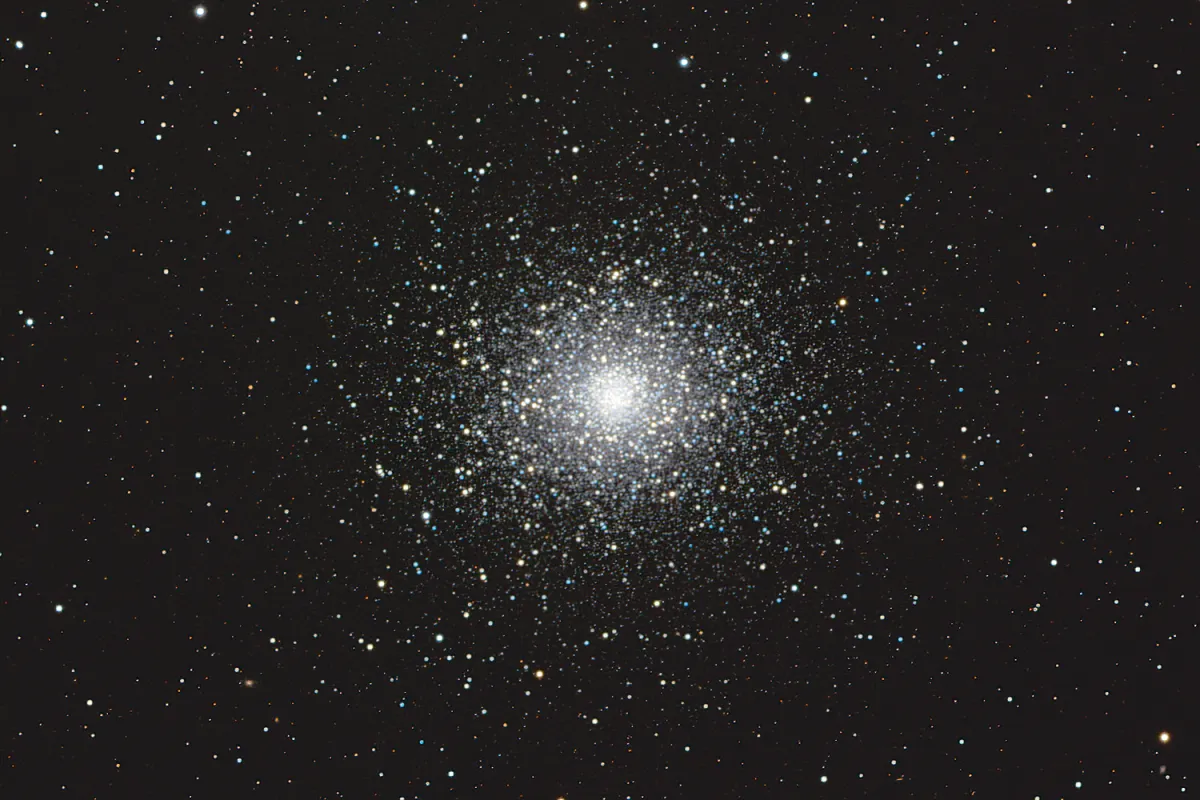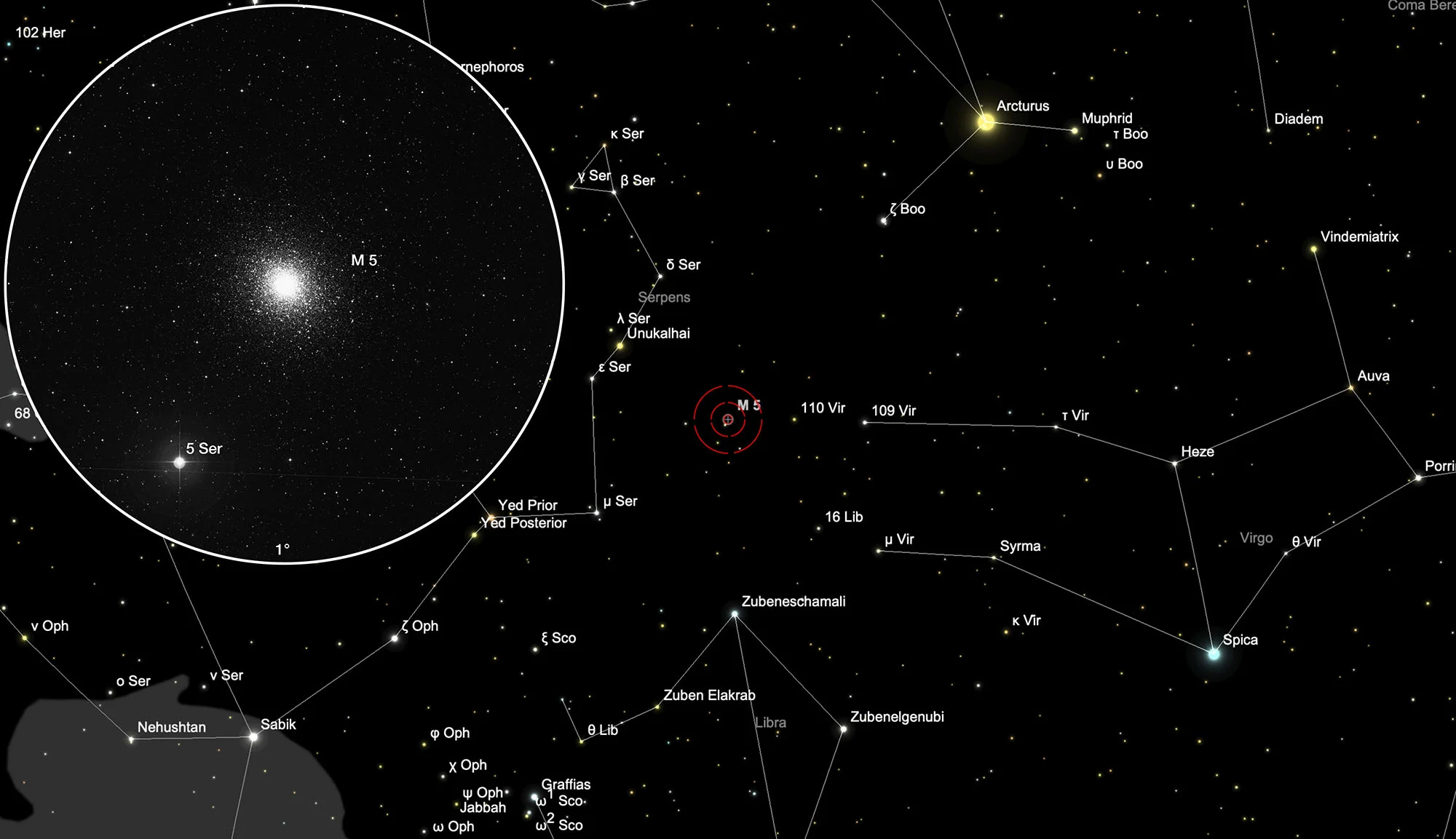Globular Cluster Messier 5

History
The discovery of the globular cluster Messier 5 is attributed to the German astronomer Gottfried Kirch, who became director of the Royal Observatory in Berlin in 1705. The records of his wife Marie Margarethe show that the discovery took place on the night of 5 May 1702, while Kirch was on the lookout for a comet. Kirch was also the discoverer of the long-period variable χ Cygni, the magnificent star cluster M 11 in the shield cloud and the great comet of 1680. Charles Messier rediscovered the globular cluster in May of 1764 and added it to his famous list as the fifth nebulous object on. As with almost all globular clusters, it was first resolved into single stars by Sir William Herschel in 1791.
Physical Properties
The star cluster has an average radial speed of 53.7 km/s and the distance is about 26'000 light years, a little further away than M 13. These two globular clusters appear almost identical in size and luminosity. The population of both clusters is estimated to be more than half a million stars, most of which cannot be made out at this great distance. Our sun at the same distance as M 5 would appear to us as a tiny asterisk of 19.4 mag. This tells us that the brightest stars in the cluster must be huge giants with an absolute magnitude of -3 or -3.5. The true luminosity of such a star is around 2000 times that of our sun. M 5 emits the amount of light from around a quarter of a million suns. [4, 145, 250]
The shape of M 5 is not spherical, but about 10 percent elliptical; the longer axis inclined at a position angle of 50°. A slightly irregular distribution of the brightest stars is also noticeable if one compares M 5 with a typically «smooth» globular cluster such as Omega Centauri. Radial star chains stand out in the outskirts of the cluster and give the impression of a spiral shape. [4]
The globular cluster M 5, with an age of 12 billion (109) years, is one of the oldest in the Milky Way. Most of its stars grew up in the same nursery and reached old age together. The most massive stars age the fastest, using up their fuel in less than a million years and ending their lives in a spectacular supernova. This process would only leave old, low-mass stars that cool down and become red giants, while the oldest stars continue to evolve into blue, horizontal branch stars.
Nevertheless, astronomers have discovered many young, blue stars in the globular cluster. It is believed that these stragglers were created either by star collisions or by mass transfer between binary stars. Such events are easy to imagine in densely populated globular clusters in which up to a few million stars are densely packed together. [250]
| Designation | NGC 5904 |
| Type | GCL (V) |
| Right Ascension (J2000.0) | 15h 18m 33.8s |
| Declination (J2000.0) | +02° 05' 00" |
| Diameter | 23 arcmin |
| Visual magnitude | 5.7 mag |
| Metric Distance | 7.500 kpc |
| Dreyer Description | !!, globular, vB, L, eCM, st 11…15 |
| Identification, Remarks | h 1916; GC 4083; M 5; GCL 34 |
Finder Chart
The globular cluster is located in the constellation Head of the Serpent (Serpens Caput), west of the Ophiuchus (Serpent Bearer). In the eastern part of the constellation Virgo (Virgin) are the two less conspicuous stars 109 Virginis (3.8 mag) and the weaker 110 Virginis (4.6 mag). This connecting line, extended by the same distance to the east, reveals the position of the globular cluster Messier 5, which is located in the immediate vicinity of the 5.2 mag weak star 5 Serpentis Cauda. This star can also be seen with the naked eye on clear, dark nights. The constellation is best observable in the months of January to October.
Visual Observation
400 mm Aperture: In the 21 mm Ethos eyepiece, the globular cluster is nicely resolvable and, together with the bright star nearby, makes for a pleasing sight. — 400 mm f/4.5 Taurus Dobsonian, Glaubenberg, 17. 6. 2023, Bernd Nies
